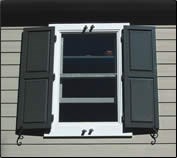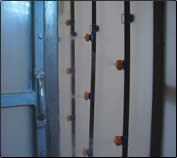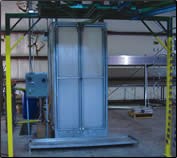Simplifying Pretreatment
Single-step process saves energy, time, disposal costs
Lookout Shutters is a small company that’s innovative in both thinking and practice. Based in a 45,000 sq ft factory in Calhoun, GA, Lookout’s 20 employees make three different lines of hurricane shutters.
The company’s swinging colonial shutters are decorative, permanently affixed and very strong. The product consists of a 16-mm thick, impact-resistant polycarbonate honeycomb core overlaid with decorative aluminum panels that are available in styles to match a variety of home designs. All the shutters are custom made to fit the customer’s windows.
According to company president Wayne Trundle, Lookout’s products are considered to be considered to be “Cadillacs” in the industry, and often are used on very expensive homes as well as in commercial applications. Given this quality reputation, the finish of the company’s line of aluminum shutters is important for both appearance and durability in tough coastal environments.
“Most of what we do is based on aluminum extrusions,” Trundle explains. “We cut them to length to make the shutter frame, then cut more pieces of extruded aluminum for hinge pieces. The other part of the hinge is a stainless steel piece we have made for us.”
All external shutter components—even the stainless hinge pieces—are powder coated individually, then assembled. “That way, there are no raw edges exposed,” Trundle says.
Insourcing Finishing
Until late 2005, the company was outsourcing all its powder coating to a nearby finishing jobshop, but quality and delivery issues were causing some concerns.
“We’d occasionally have rejects for too light a coating, or too heavy, or other finishing defects that we just couldn’t let slide,” Trundle recalls. “The big thing was the downtime that resulted. These guys were running an automated system, and we just couldn’t take a handful of parts to them and get them repainted. They do a lot of reclaim spraying and high-volume jobs, and they just had to fit our stuff in when they could.
“They would always redo them—that wasn’t the problem,” he continues. “The problem was, it might take three weeks to get our parts back. They just weren’t set up to do the type of work we were looking for.”
Lookout began exploring the idea of bringing finishing in-house. Among the main issues the company faced were waste treatment and a lack of floor space. The company had no drain, and not more than 10,000 sq ft or so of the factory could be devoted to the finishing operation.
One of the first parts of the finishing system Trundle looked at was pretreatment. “Our finishing supplier used a conventional three-stage pretreatment system for cleaning and phosphating,” Trundle explains. “We knew that kind of big automated system wasn’t going to work for us. It just wasn’t what we wanted to do. Our process is a batch-type process, and it works very well for us. We’re oriented toward custom production. We do production stuff, but everything is produced as a custom fit for a home or business.”
Trundle did some research to see what else was available, and came upon Plaforization, a single-stage, room-temperature pretreatment process that uses no water, creates no sludge or solid waste, and works in 60 to 90 sec in a dip or low-pressure spray application. (See sidebar for more information on the process.)
From there things moved quickly. Lookout tested the Plaforization fluid in October 2005, received a quote for materials and equipment in November, and were operational in January 2006.
At Lookout, parts are pretreated in a batch spray washer that takes very little space on the plant floor. The unit’s 400-gal tank is only 6 × 6 × 3 ft, and is partially buried in the plant floor. The flowcoat housing is 4 ft wide, 12 ft long, and 8 ft high. The cabinet features 12 spray nozzles, six on either side. A single track runs into the wash, which is set up “kind of like a big dishwasher,” Trundle explains.
“You open the doors, slide the parts in, close the doors, turn it on, and it sprays stuff everywhere in there,” he says. “Then you allow the solution to drip off and reclaim it, because the chemical itself is quite expensive.”
The unit is on a timer, so racked parts are pushed along the conveyor into the unit, the door is closed, the timer is set, and the unit runs its treatment and drip-off cycle. Lookout currently runs a three-minute spray cycle, although 60 to 90 sec is more typical for the spray cycle.
“When the door is opened the parts are ready for the dry-off oven,” Trundle explains. “The rest of the production cycle—powder coating and curing—takes much longer than the pretreatment does.”
Lookout’s washer consists of a stainless steel frame with polypropylene sheets that make up the cabinet surfaces. The tank is stainless, and plumbing is all stainless or polypropylene. “The fluid will soften and break down PVC and other types of plastics,” Trundle explains.
The spray system uses very low pressure—maybe five psi. “It’s called flow coating,” Trundle says. “It basically bathes the parts in the solution, which works on any kind of metal—there’s nothing we do different from steel to stainless to aluminum. The fluid also contains a minor amount of phosphoric acid, so we actually get a bit on an etch that helps with adhesion,” he adds.
The fluid encapsulates and absorbs oils, Trundle explains. “Most of our stuff is aluminum, and it’s clean. We use a water-soluble fluid for cutting that washes off very easily, so we have really no problems with defects and rejects.
“It won’t do anything to clean heavy waxes or silicones, because it really doesn’t use heat or pressure like some other pretreatments,” he adds. “But light cutting oils or oils from the manufacturer, it will clean that off and absorb them into the solution. Depending on the amounts and concentrations of those you pick up over a period of time, you may have to adjust the solution concentration. But you never have to dump it, it doesn’t create sludge, and there’s no real maintenance.”
According to Trundle, the process works equally well on any of Lookout’s substrate materials. “We’ve done some in-house testing for adhesion and curing,” Trundle says. “Adhesion is just about the same as we were getting from our outside vendor, and I don’t know of any problems we’ve had with rejects.
The ability to work with a variety of metals is a plus, because the company now does custom powder coating when the system is not running in-house production. Trundle says Lookout Powder Coating now accounts for about 10% of his business, and much of the work is one-off.
“We do a lot of work for hot rod and motorcycle builders, and there’s no telling what they’re going to bring us,” he says. “It doesn’t matter whether we’re hanging an intake manifold, an engine block, a motorcycle frame, or anything else. The system works just as well on any of it. That was important to us, because when we put this line in we first made sure it worked well for us. But we’re always looking to get the most out of what we do, so we began looking for work we could bring in and offset some of the equipment costs.”
Parts exiting the spray unit are clean and have a little bit of film left on them. An air blow-off salvages excess fluid, then drying facilitates formation of the organo-phosphate coating.
“Treated parts go straight into the powder booth,” Trundle says. “There’s no cleanup. The only thing is, the fluid will evaporate, so you want to keep the system as contained as you can with vapor shields and things like that. The fluid is kind of expensive, but once the initial investment is done it’s just a matter of keeping it to an operating level.”
Multiple Benefits
Fluid costs aside, Trundle is convinced that Plaforization pretreatment was the best option for his company, and he ticks off the benefits of the system like someone who’s had experience giving guided tours—which he has. “We’ve had quite a few people through here to look at our pretreatment process,” he says. “Some of them even ran parts through it, then took them and coated them and compared them to parts from their conventional pretreatment process.”
For Lookout, one of the big pluses of Plaforization was its simplicity compared with conventional pretreatments. “We didn’t have a lot of experience to fall back on,” Trundle says. “When we decided to bring finishing in-house, we were looking for something that was easy and took up less space.”
The process works at ambient temperature, requiring no heat and working well over the range of temperatures experienced in the Georgia shop. “It works just as well in cool or hot weather; we haven’t noticed any difference, because the solution does all the work,” Trundle says. “That was another nice thing about this: there’s no warm-up time. You don’t have to wait for the solution to come to temperature, you can come in first thing in the morning and start running parts.”
Finally, the system works without the maintenance required for conventional pretreatments. “We’ve never even maintained our system, and we started in January 2006,” Trundle says. “This is a one-stage, one-step process that has no sludge buildup, no maintenance and no tank dumping. We just keep the solution at an operating level, and every quarter we send a small bottle of the stuff off for analysis. Carpenter lets us know what contaminants we have, and if there’s anything in there that may be detrimental to our finish. So when you factor in time and labor to do maintenance and de-sludging and wastewater containment and disposal, this was a no-brainer for us.”
Related Content
Reduced, Reused and Recycled Powder Coatings Are the Future
They say necessity is the mother of invention, and with millions of pounds of powder coating going into landfills a year, these two companies have found novel approaches to dealing with this waste stream.
Read MoreCuring Oven Basics
Simply heating up the substrate does not cure the coating. There are many variables to consider when choosing the best cure oven for your application...
Read MoreProducts Finishing Reveals 2023 Qualifying Top Shops
Each year PF conducts its Top Shops Benchmarking Survey, offering shops a tool to better understand their overall performance in the industry. The program also recognizes shops that meet a set of criteria to qualify as Top Shops.
Read MoreConveyors and Paint Systems
Choosing the right conveyor system, coating technology, and ancillary equipment.
Read MoreRead Next
A ‘Clean’ Agenda Offers Unique Presentations in Chicago
The 2024 Parts Cleaning Conference, co-located with the International Manufacturing Technology Show, includes presentations by several speakers who are new to the conference and topics that have not been covered in past editions of this event.
Read MoreEpisode 45: An Interview with Chandler Mancuso, MacDermid Envio Solutions
Chandler Mancuso, technical director with MacDermid Envio discusses updating your wastewater treatment system and implementing materials recycling solutions to increase efficiencies, control costs and reduce environmental impact.
Read MoreDelivering Increased Benefits to Greenhouse Films
Baystar's Borstar technology is helping customers deliver better, more reliable production methods to greenhouse agriculture.
Read More

























